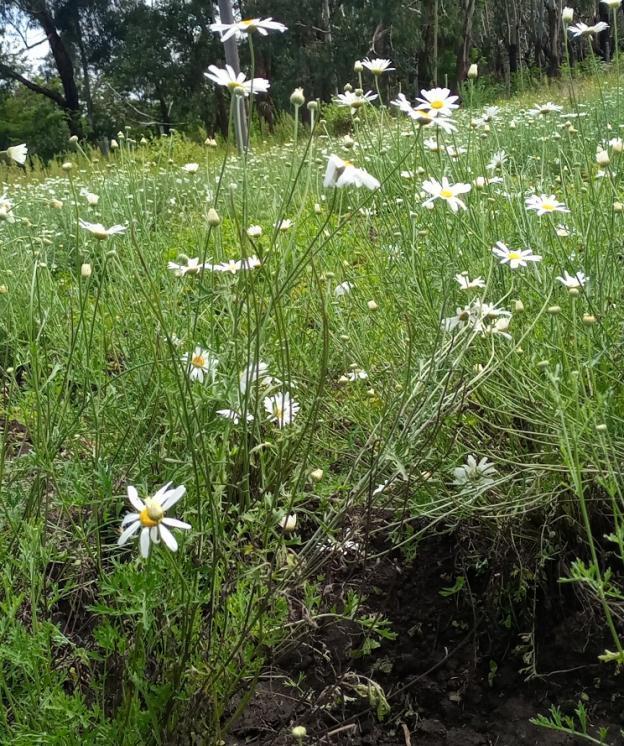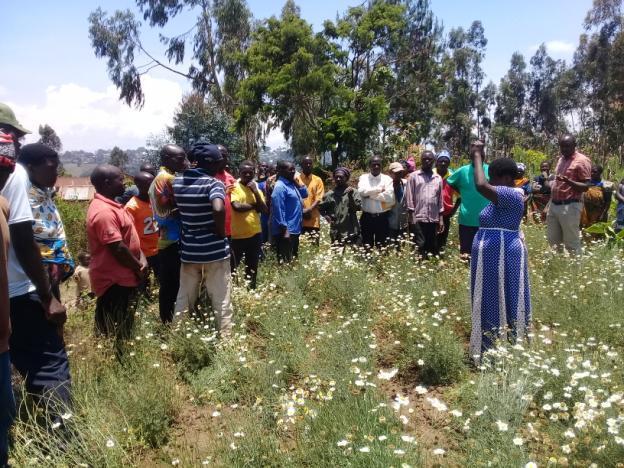1.0 Introduction
Pyrethrum, (Chrysanthemum cinerariaefolium L.) is a perennial herb, belonging to the family compositae. Pyrethrum is grown for the production of pyrethrins which are used to control many human and household pests such as mosquitoes and houseflies. Pyrethrum grows well from 1800 to 3000 metres above sea level (m.a.s.l). In Tanzania, regions growing pyrethrum are Mbeya (Mbeya rural), Songwe (Ileje), Njombe (Ludewa and Makete), Iringa (Mufindi and Kilolo), Arusha (Almeru), Manyara (Babati and Mbulu)

Pyrethrum Plant
2.0 Brief Pyrethrum research history
Pyrethrum research in Tanzania began in 1963 at Igeri Substation in Njombe. Later in 1973 was moved to TARI-Uyole headquarters formally ARI-Uyole. Pyrethrum research is a national programme coordinated from TARI-Uyole in Mbeya. It is the only centre dealing with this unique crop.
Offstations (testing sites) which supported the headquarters were Ujuni village located at 2,500m.a.s.l and Kinyika village at 2,600 m.a.s.l both located in Makete district. Active sites for research todate are ARI Uyole (headquarters) Igeri, Kinyika, and Ujuni.
3.0 Activities conducted
3.1 Breeding
Different promising clones have been developed in the course of research work which has helped to improve pyrethrum production for yield and pyrethrin content in the farming community. Clones with both high yields and pyrethrin content were developed and disseminated as recommended cultivars for altitude from 1800m to 2600m a.s.l.
The clonal cultivars had/have the following attributes:
Table 1.0 : Clones/crosses developed since 1963 and beyond
|
S/NO |
Clone no. |
Dry matter yield (Kg/ha) |
Percent Pyrethrins content (%) |
|
Research from 1963 to 2007 |
|||
|
1. |
60/70 |
700 |
1.70 |
|
2. |
65/166 |
800 |
1.60 |
|
3. |
65/194 |
900 |
1.50 |
|
4. |
78/94 |
977.1 |
1.88 |
|
5. |
79/78 |
852.5 |
1.92 |
|
6. |
79/71 |
756.5 |
1.89 |
|
7. |
78/111 |
739.3 |
2.07 |
|
Current promising clones under research 2008 to 2017 |
|||
|
8 . |
10/7 |
1647 |
1.94 |
|
9. |
10/8 |
1731 |
2.17 |
|
10. |
10/9 |
1532 |
1.88 |
|
11. |
10/13 |
1446 |
1.67 |
|
12. |
10/24 |
2168 |
1.90 |
|
Current Promising crosses |
|||
|
13 |
5a |
816 |
1.73 |
|
14 |
5b |
925 |
1.69 |
|
15 |
6a |
807 |
1.67 |
|
16 |
6b |
817 |
1.66 |
|
17 |
7 |
852 |
1.72 |
3.3
Agronomy
Agronomic factors for increased pyrethrum production have been studied such as plant spacing (60*30 cm), time of planting, nursery bed preparations, fertilizer recommendations, pyrethrum drying (improved fire wood drier) and equipments for pyrethrum flower drying, weeding and intercropping pyrethrum with beans.
3.4 Pyrethrum Products Utilization
The use of pyrethrum marc or grist in the farmers fields for pest control in maize and horticultural crops, maize in store were also studied for research and development (R &D). However, further research in this area is required.
3.5 Technology transfer
Outputs from research to farmers have been transmitted to farmers through demonstration, media, leaflets and training in collaboration with extension services and private sector, especially the Pyrethrum Company of Tanzania (PCT) located in Mafinga district in Iringa region. Some extension leaf lets and manuals had been prepared, pyrethrum extension leaflets produced include UAC extension leaflet no. 55,( Kilimo Bora Cha Pareto toleo la mwaka 2010, Kilimo Bora cha Pareto toleo la mwaka 2018). Futhermore, dissemination is conducted through trainings (flower picking and drying, true pyrethrum seed production, seedbed preparation and planting), media (TVs, Radio, and Newspapers) and exhibitions (Nane Nane and Agribusiness Expo).

Training on seed production
4.0 Ongoing Projects
4.1 Breeding activities include
1. Pyrethrum biclonal crosses at TARI Uyole and Igeri sites
2. Pyrethrum parental materials maintenance at Uyole
3. Pyrethrum germplasm maintenance at Uyole and Igeri (206 clones)
4. Pyrethrum composite seed production at Igeri (0.5 acres)
All the above projects
are conducted in collaboration between TARI-Uyole and Pyrethrum Company of
Tanzania (PCT). The overall main objective for all trials is to come up with
recommended and released varieties better than the present materials with high
pyrethrum dry flower yields greater than 1200kgDm/ha/year and pyrethrin content
greater than 2.0 %.

